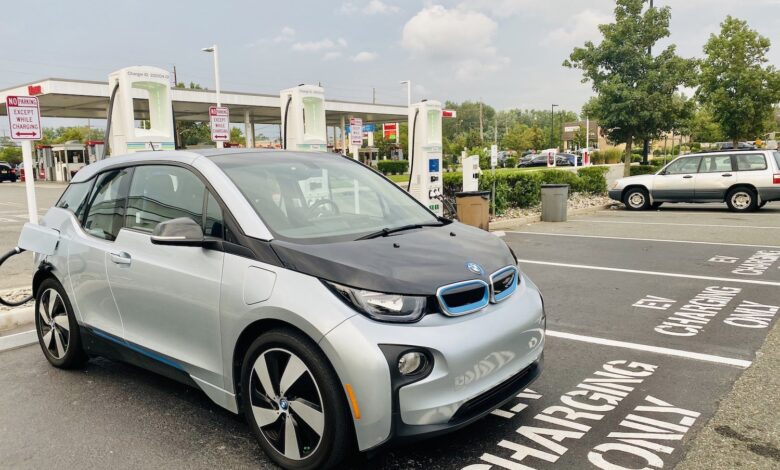The ultimate guide to road-tripping with an electric car

The pandemic changed the world in many ways, but two stand out most to me: road trips and electric cars.
Two years on, road trips continue to be the preferred means of transport for most Americans heading on vacation. This year, Memorial Day road trips were up 6% compared to 2022, with an estimated 37.1 million Americans driving to their destinations, according to AAA Travel.
At the same time, more and more drivers are switching to electric cars, with usage steadily rising both in the U.S. and abroad. Axios data from May 2022 showed that 4.6% of the new vehicles registered in the U.S. were electric; that’s more than double electric vehicles’ share of monthly registrations for May 2021 (1.9%).
Consumer interest in EVs also appears to have reached a tipping point. More than 50% of those planning to buy a car are opting for either a fully electric, plug-in hybrid or hybrid vehicle, according to Ernst & Young’s 2022 Mobility Consumer Index.
Related: 5 lessons learned from taking a road trip in the age of coronavirus
After a summer of rental car road trips, I bought into both trends and purchased a 2016 BMW i3. It’s an extended-range electric compact car with a small gas motor that can charge the battery on the go. This, combined with the car being a hatchback, makes it — in my opinion — the ultimate road trip vehicle for those living in a major city like New York City.
It’s a different experience than road-tripping with a gas car, and newcomers to the electric car world might be deterred if they don’t know what to expect. In this article, I’ll share some tips I’ve picked up while on the road with my EV. I’ll discuss what to look for when buying an EV for road trips, how to find charging stations and how to plan trips.
Let’s dive (drive?) in.
Choosing an electric car for road trips
There are some important things to consider if you’re in the market for an electric car and plan on road-tripping it. Here are a few things to consider as you go through the car-buying process. Some of these include range and whether or not you should consider purchasing a plug-in hybrid instead.
Sign up for our daily newsletter
Related: Should I buy a used car instead of renting this summer?
Criteria for a road trip-capable electric car
It’s important to look for a car that has an appropriate range for trips that you plan to take. Of course, as the technology has improved, you’ll find most 2023 electric vehicles have at least a 200-mile range (though over 350 miles is actually more common).
If you are buying a used vehicle, don’t choose one that has an 80-mile range if you plan on taking 500-mile road trips regularly. That said, you don’t need an ultra-long-range, newer-model electric car if you primarily drive in the city with just a few occasional longer trips. The 2020 Nissan Leaf has a 150-mile range and — if you don’t mind making a few stops — can be a good bet for long trips.
If you want to avoid frequent charges and enjoy the spontaneity of venturing off-route once in a while, consider a long-range vehicle. While you’re subject to fewer charging stops, you’ll generally spend more on the car. This is especially true in the used car market, where long-range cars tend to have a higher resale value.
There are many splashy 2023 SUVs and sedans with ranges that well exceed 300 miles, including the Tesla Model S (with an estimated range of 405 miles) and the BMW i7 (318 miles). In the 200-mile-plus category, there’s the more economical Chevrolet Bolt EV (259-mile range) and Kia Niro EV (253-mile range).
Related: The pros and cons of Amex’s Auto Purchasing Program
Consider a plug-in hybrid or extended-range vehicle
Further, you may want to consider an electric car that’s not fully electric. You have two options here: plug-in hybrids and extended-range electric vehicles. The former are standard hybrid vehicles with larger batteries that can be charged externally. These cars generally have 15 to 50 miles of electric range and full-size gas tanks.
That said, these vehicles don’t have a fully electric driving experience and don’t generally offer fast charging options (more on that soon). I find these cars less fun to drive and — if you want to drive in electric mode — considerably more inconvenient to charge. At the same time, they can make great road trip vehicles with gas engines.
On the other hand, extended-range electric cars are fully electric vehicles with small gas motors. This motor effectively charges the car’s battery to provide additional range when driving long distances. My BMW i3 is equipped with the extended-range option, and it’s saved me on longer trips when I find myself far away from a public charger.
I prefer extended-range cars to plug-in hybrids since you always have the electric driving experience (think immediate torque). These cars are also usually equipped with fast charging and other EV-specific technology features. On top of this, many plug-in hybrids can’t drive in an EV-only mode, which makes them feel more like a traditional gas vehicle. Extended-range vehicles don’t have this issue since they always drive on electricity.
Related: The best credit cards for purchasing a car
Fast charging is key for a road trip
Here’s a big one: Only purchase a car with included Level 3 direct-current fast charging (or Tesla Supercharger) if you plan on road-tripping. More and more fast chargers are popping up around the country with “hyper-fast speeds” (the term coined by Electrify America’s new DC labeling system) of up to 350 kilowatts — allowing a full charge in as little as 20 minutes.
On the other hand, a vehicle without this option can only use Level 2 public chargers (up to 240 volts). These can charge with an output of about 11 kilowatts per hour, which means you are adding between 20 and 30 miles of range for each hour of charge time; this varies, of course, according to the vehicle. While this is still faster than plugging in at home, it will take a ton of extra time to charge when on the go. My BMW i3, for example, takes about three hours to charge from 0% to 80%.
This option is even more important when on long road trips. If you have to wait hours every time your vehicle runs low on battery, it will take a long time to reach your destination. On the other hand, a 30-minute stop is enough time to grab lunch and set navigation to your next charge point or final destination.
Thankfully, almost all new fully electric vehicles and extended-range cars are equipped with fast charging. Some older electric cars don’t have this option, so inquire about it before you go for a test drive. Some cars that aren’t equipped with this feature include some 2014 and 2015 BMW i3s, all models of the Fiat 500e and some older Nissan Leafs.
Check battery degradation when buying a used car
Plan on buying used? Make sure to check the car’s battery status before you buy. Like all batteries, the battery inside an electric car will degrade over time. This is normal, but excessive degradation can complicate your road trip. You can usually check the battery status on the car’s infotainment system.
Thankfully, most electric cars have long battery warranties. For example, my used BMW i3 has a 100,000-mile/eight-year warranty on the battery, meaning that I’m covered through 2024 on my 2016 model. According to BMW, a battery replacement can be authorized if a battery degrades 30% or more during the warranty period.
How to plan a road trip with an electric car
As discussed, road-tripping with an electric car is different than with a gas car. It requires a bit more planning, which — while tedious — isn’t too bad once you get the hang of it. Let’s take a look at how I plan road trips in my electric car.
Plan your route around fast chargers and be mindful of range
First thing first: You’ll need to charge when out on the road. When planning out your road trips, you must map your driving route around available public chargers near highways, expressways and wherever else you’re driving. You’ll need to charge before your battery dies to call roadside assistance, but there’s a bit more to it than this.
Unfortunately, electric car range is dynamic. You’ll use more battery when accelerating quickly, going up hills and using climate control. That said, always give yourself at least a 10% buffer when looking for chargers. This means that if you have an older car with a 100-mile range, find chargers that are no more than 90 miles apart.
Also, stick to fast chargers when you’re on the road. This ensures you’re not stuck at a given charger for hours while waiting for your car to charge. Instead, you can plug in for 30 to 40 minutes and get back on the road without issue.
You can plan your trips manually, use your car manufacturer’s branded app or download an app like PlugShare. I’ll go in-depth on this app in the next section, but in short, it’s a crowdsourced directory of all chargers available near your location. The app’s built-in route planner can be a huge timesaver when planning long, multicharge road trips.
Look for hotels with charge points
Another way to save time on charging is by staying at hotels that offer electric car charging in their parking lots or garages. These have become increasingly common, and often charging is either free or included with the parking fee. These are generally Level 2 chargers, though, so they’re best suited for charging overnight.
No charging at your hotel? Ask the hotel staff if it has an outdoor plug you can use. Most electric vehicles include a Level 1 wall charger that can be used with any standard wall socket. If the hotel is OK with it, this charger will slowly charge your vehicle overnight and give you at least enough power to make it to your next destination.
Related: 7 mistakes every road-tripper makes at least once
Use these apps and charging networks to find public chargers
Now that you know how to plan a trip, let’s take a look at the best way to find public chargers. As mentioned in the last section, several charging networks exist nationwide here in the U.S., including ChargeHub, ChargePoint and Electrify America. That said, there are many non-networked public chargers that you can find in parking garages and on city streets.
Here’s a look at the apps and charging networks I use on electric car road trips. Make sure to download the apps before you head out on your first electric road trip.
PlugShare for most public chargers
PlugShare is a community-powered electric charger app. You can use this app to view networked, non-networked and home chargers that are open to the public. Even better, you can sort chargers by speed, connector type and whether or not you have to pay to use them. This can be immensely helpful when finding a fast charger on a long trip.
Further, the app has a trip-planning feature to help you find electric car charge points along a given route. Enter your origin and destination, and the app will show you all the chargers nearby. You can even input your car’s range to plan your route around charging stops.
Tesla owners are in luck: The ChargePoint app shows all Tesla Destination Chargers, Superchargers and other compatible chargers on the map. Just toggle on the Tesla connector in the app, and they’ll appear on the map.
ChargePoint has chargers around the US
ChargePoint is one of the biggest electric car charging networks in the U.S., offering both Level 2 and Level 3 chargers in major cities and along some major highways. Many ChargePoint locations will show up in the PlugShare app, but I recommend downloading both apps as PlugShare will often miss specific chargers. Also, you can use the ChargePoint app to pay for charging at several charging locations.
One word of warning: The ChargePoint app sometimes shows chargers that aren’t available for public use. This is especially the case here in New York, where many city vehicles have transitioned to plug-in hybrids or fully electric vehicles. Keep an eye out for this when you find places to charge.
Electrify America for DC fast chargers near highways
In the Northeast, I almost exclusively use Electrify America chargers on road trips. The company has a huge network of “hyper-fast” chargers (power delivery up to 350 kilowatts) and “ultra-fast” chargers (up to 150 kilowatts).
Electrify America operates one of the largest DC fast-charger networks in the U.S., with over 800 charging stations. By 2026, the company aims to expand its footprint rapidly in the U.S. and Canada, growing to roughly 10,000 chargers at 1,800 stations.
Charges are both within cities and near major highways, usually at Walmarts, Targets and shopping centers.
The pricing is pretty reasonable, too. It varies based on how fast you charge, and you can get a discount by signing up for a membership ($4 per month).
Using these chargers is remarkably simple, too. Just drive up, plug in your car and select the charger you’re using on the Electrify America app to start charging. The charge fee is billed to your credit card after you’re finished.
Earn bonus miles on electric car charging
Since you’ll usually pay for charging when on the road, why not earn miles in the process? Most chargers do not code as travel, so you’ll want to use a credit card that earns extra points on everyday spending. There’s a variety of these cards on the market, with our favorites being:
If you’re completing a credit card spending requirement, you may want to use it to pay for your charging. For example, I use my Delta SkyMiles® Reserve American Express Card to pay for charging so I can earn bonus Medallion Qualification Miles to qualify for Delta elite status.
Related: Maximizing points and miles on summer road trips
Bottom line
Road-tripping in an electric car is different than in a gasoline car, but it’s still a ton of fun. In fact, I’ve often found that road trips are more enjoyable in my EV as I see new places I otherwise wouldn’t. On top of this, you can use the money you save on gas to stay in better hotels and eat at nicer restaurants. Sounds like a win-win to me.
I think the biggest takeaway is to always be mindful of your range. Planning your route along charge points and stopping to charge before you need to charge are key to an enjoyable and stress-free trip. If this isn’t for you, consider an extended-range electric car or a plug-in hybrid for more flexibility.
Drive safe!




